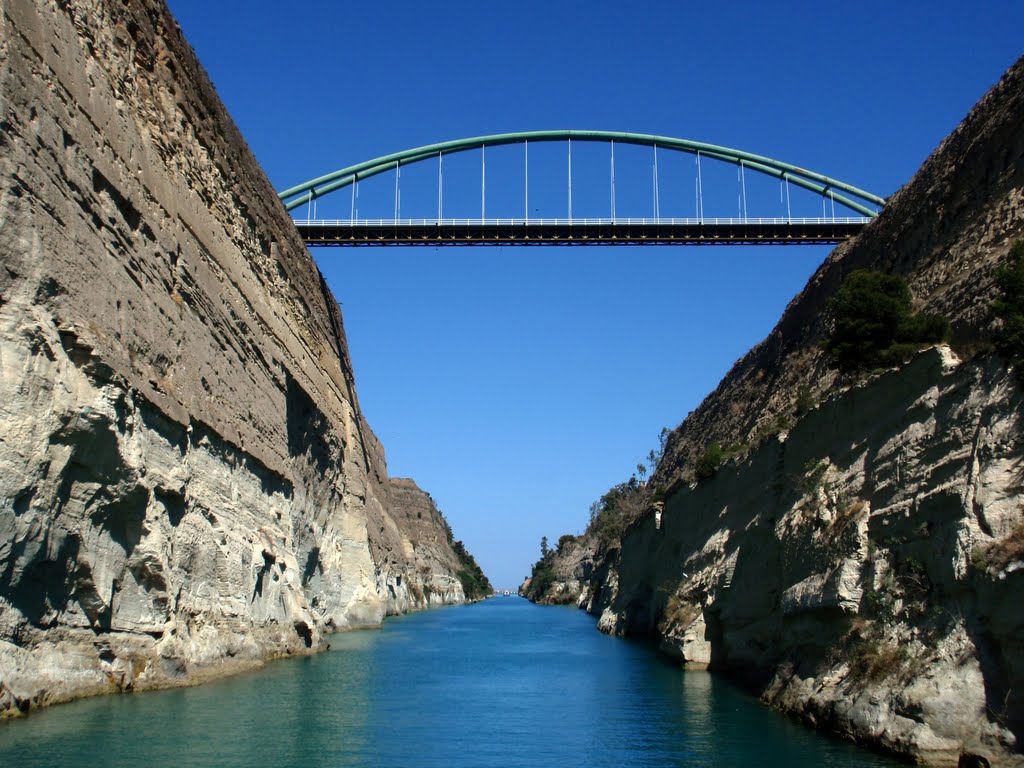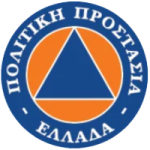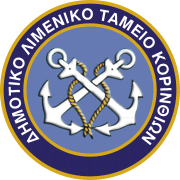
The Isthmus of Corinth is a narrow strip of land that connects Central Greece with the Peloponnese, while the canal that has been cut through it connects the Saronic Gulf with the Corinthian Gulf. It is about 6 km long, and the narrowest point is where the Corinth Canal (1880-1893) was constructed. It was a strategic location, and for this reason, a wall was built there as early as ancient times (late 5th century BC), which remained preserved until the Byzantine period (Examilion).
The Corinth Canal is a waterway that connects the Saronic and Corinthian Gulfs, located at the Isthmus of Corinth, just east of the city of Corinth. The canal is 6,346 meters long, 24.6 meters wide at the surface, and 21.3 meters wide at the bottom, with a depth ranging from 7.50 to 8 meters. It was constructed between 1880 and 1893 under the direction of the Greek engineer Petros Protopapadakis. Its construction was a result of the development policy of Prime Minister Charilaos Trikoupis, who aimed to create a modern and economically developed state by undertaking major infrastructure projects.
Since ancient times, the Isthmus has been the most important strategic point in Greece and one of the most significant in the Eastern Mediterranean.
The idea of opening a canal was a major issue from antiquity, as the creation of the canal would solve many problems and facilitate navigation and trade.
Thus, the tyrant of Corinth, Periander, was the first to conceive the project of opening the Isthmus around 602 BC. However, he ultimately settled for the creation of the diolkos, as the social and economic conditions of the time did not allow him to realize his vision.
Subsequently, Demetrius Poliorcetes, Julius Caesar, Caligula, and Nero all studied and attempted to open the canal, but without success. In fact, Nero, in 67 AD, began excavation work using thousands of workers and proceeded over a length of 3,300 meters.
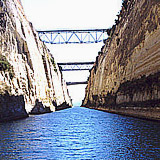
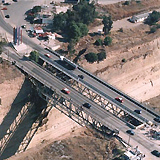

Herod Atticus, followed by the Byzantines and later the Venetians, were Nero’s “successors” in the vision of opening the Isthmus. Each attempted the grandiose project in turn, but abandoned the effort for various reasons.
After the Ottoman occupation, the newly established Greek state seriously reconsidered the idea of opening the Isthmus. In 1852, L. Lygounis, who had served as director of the Nile works, drew up a plan for cutting the Isthmus and submitted his proposal to the Greek government. Ten years later, the French engineer Grimant De Caux presented his own proposals to the Greek Parliament. Both, however, were deemed unfeasible by the Greek state.
However, when the Suez Canal was completed in 1869, the Government of Th. However, it was not successful, and the project fizzled out. In 1881, the project was awarded to General Stefanos Tyrr, along with the privilege of operating the bridge for 99 years.
The works began on 23-4/5-5 of the following year with great solemnity, in the presence of the king and the royal family. The most economical and effective method chosen was the one used by Nero, with a total length of 6,300 meters. On 25-7/7-8 of 1893, after the project had been undertaken by the Greek company “Corinth Canal Company” under A. Syngros, Queen Olga, amidst cannon fire, cut the ribbon of the Canal’s inauguration with golden scissors. The first ship then officially sailed through the Canal.
The canal, for the construction of which 2,500 workers and the most sophisticated machinery of the time had been used, had a total length of 6,343 meters, a width of 24.6 meters at sea level, and 21.3 meters at the bottom, with a useful depth of 7.5 to 8 meters. A total of 12 million cubic meters of earth had been excavated for its construction, and retaining walls were built along its entire length, rising up to 2 meters above sea level.
The “Company of the Corinth Canal” operated the Canal until 1906, when it was taken over by the National Bank of Greece through the “New Joint Stock Company of the Corinth Canal.” Finally, on November 1, 1980, the operation of the Canal was transferred to the Greek State, which, by Law 1067/80, established the “Corinth Canal Joint Stock Company” to operate the Canal until recently.
In its 107 years of operation, the Canal has been closed intermittently, primarily due to the collapse of its slopes because of the peculiar geological composition of the area.
Until 1940, it remained closed for a total of 4 years due to collapses, culminating in 1923 (when it was closed for 2 years). In 1944, during their withdrawal, the Germans caused the fall of 60,000 cubic meters of earth, and the restoration works lasted 5 years.
There are currently two submerged bridges in operation at the Canal—one in Posidonia and one in Isthmia—that serve communication between Central Greece and the Peloponnese. Each year, the most famous canal in Greece is navigated by approximately 15,000 ships from at least 50 different nationalities, making it the undisputed maritime “umbilical cord” between the Western and Eastern Mediterranean.
